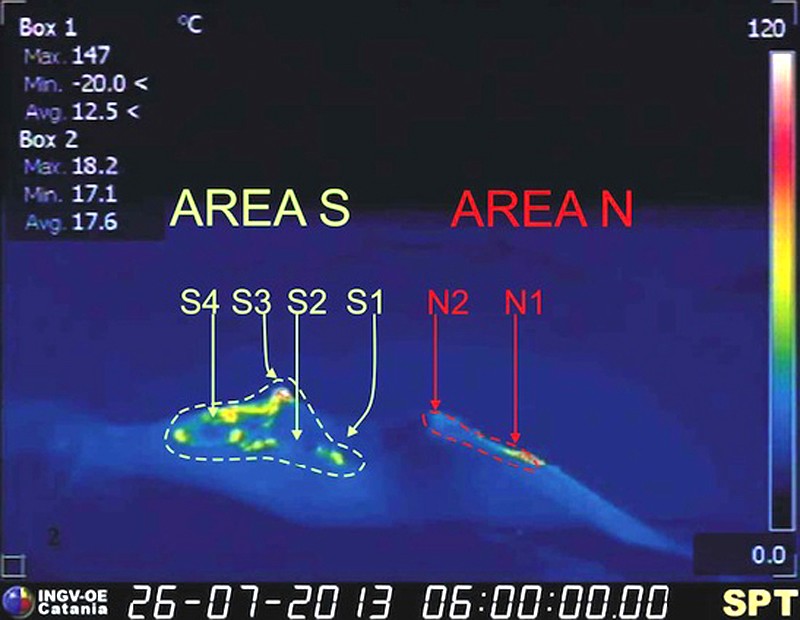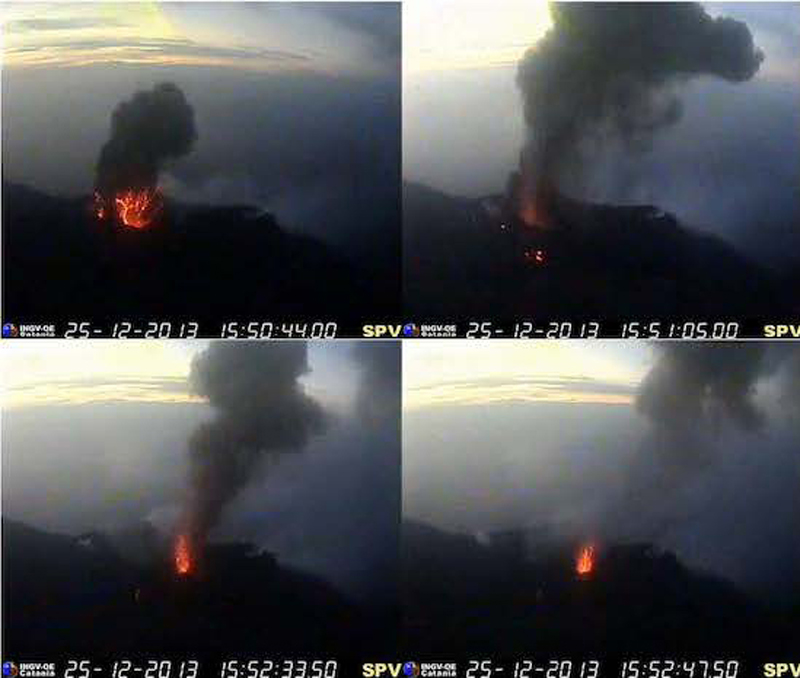Report on Stromboli (Italy) — November 2015
Bulletin of the Global Volcanism Network, vol. 40, no. 11 (November 2015)
Managing Editor: Edward Venzke.
Edited by A. Elizabeth Crafford.
Stromboli (Italy) Lava flows and ash plumes complement classic Strombolian activity of spattering; lapilli and bombs through December 2013
Please cite this report as:
Global Volcanism Program, 2015. Report on Stromboli (Italy) (Crafford, A.E., and Venzke, E., eds.). Bulletin of the Global Volcanism Network, 40:11. Smithsonian Institution. https://doi.org/10.5479/si.GVP.BGVN201511-211040
Stromboli
Italy
38.789°N, 15.213°E; summit elev. 924 m
All times are local (unless otherwise noted)
Italy's Stromboli volcano, located on the N side of the Aeolian archipelago in the Tyrrhenian Sea, is best known for its iconic lava fountains that have graced its summit essentially continuously for at least the last 400 years. Confirmed historical observations of its eruptions go back 2,000 years. In addition, lava flows, tephra explosions, and pyroclastic flows have all contributed to its geologic history.
Stromboli continued its frequent, mild explosive activity through the end of 2013, with a few additional noteworthy events which are well documented in weekly reports by the Instituto Nazionale de Geofisica e Vulcanologia (INGV) Sezione de Catania. These reports are briefly summarized below. INGV monitors the gas geochemistry (CO2 and SO2), deformation, and seismology, as well as the surficial activity at Stromboli. The thermal camera located on the Pizzo sopra la Fossa near the summit was restored in July 2013. This allowed renewed visual monitoring of the eruptive activity which consistently occurs from two well defined crater areas at the head of the Sciara del Fuoco (figure 84), a large scarp that runs from the summit down the NW side of the island (see BGVN 36:09 for a detailed geologic map).
Strombolian activity at low-to-moderate intensity occurred throughout the year; periodic, brief, high-intensity explosions also occurred. Additionally, several small lava flows in March, April, and May from the North Crater area (Area N) sent material down the Sciara del Fuoco to the sea. A large lava flow during 17-18 April created a large MODVOLC thermal anomaly, and caused abundant steam plumes from material entering the sea. From September through the end of the year, explosive activity increased significantly at the South Crater (Area S) with a marked increase in the frequency of eruptive activity, as well as two significant high-intensity explosive events on 4 and 25 December.
Vents in both the northern and southern areas consistently produced predominantly coarse material (lapilli and bombs) at low-to-medium intensity throughout 2013. The ejecta generally rose to heights of 80-150 m during explosions that occurred with a low-to-moderate frequency rate of 6-12 per hour. The ejecta tended to be deposited on the upper part of the Sciara del Fuoco and caused minor landslides consisting of small bombs and lava fragments.
During 27-28 February a lava flow came from the N2 vent where intense spattering caused incandescent material rolling down the slope to transform into a continuous lava flow down the N side of the scarp. The lava flow eventually reached the coast and created dense clouds of steam on contact with the seawater. A second flow also traveled down the same area of the flank during 1-2 March.
On 13 and 14 March intense spattering from the N Area evolved into a lava fountain and caused a small flow down the N side of the scarp (Sciara del Fuoco). SO2 flux values increased from average levels of 260 t/d to as high as 800 t/d during this event. Additional small lava flows from the N Area were observed on 3, 12, and 13 April.
During 17-19 April, two large lava flows emerged from the N Area and flowed about 400 m down the Sciara del Fuoco. The cooling lava front produced large lava blocks that rolled down the slope to the sea, creating large steam plumes which lifted abundant lithic particles (figure 85). The heat from this flow was recorded in the MODVOLC thermal anomaly data as 15 pixels during 17-19 April.
 |
Figure 85. The lava flow of 17 April 2013 produced from both of the vents in the N Area of Stromboli. Courtesy of INGV, photo by F. Murè (Stromboli Weekly Bulletin, 23 April 2013). |
Additional smaller lava flows during 26-28 April created numerous minor landslides and were accompanied by seismic tremors. During May the N Area remained active, with vigorous lava spattering from N2 on 1 May, and an ash cloud from N1 on 3 May. The lava spattering sent large fragments down the scarp and created a flow that reached several hundred meters before breaking into blocks that rolled down to the sea. Average-to-high-intensity explosions of coarse material occurred on 5 May from the S Area vents, and another lava flow from N2 was recorded on 7 May.
Activity decreased significantly at the N Area vents after early May, and intensity and frequency of events increased at the S Area beginning in June. In late July when the thermal camera on the Pizzo sopra la Fossa was restored, observations of the volcanic activity at the S Area were significantly improved. INGV also began plotting the average number of hourly explosions at the end of July (figure 86). Values for the second half of the year averaged less than 10 events per hour, except for increased activity in the S Area in mid October and November.
In August, the frequency and intensity of explosions briefly increased at vent S4, with periods of vigorous spattering, strong incandescence, and some projectiles exceeding 150 m in height from the crater terrace. A short episode of medium-intensity (80-150 m high) explosions was recorded on 27 August from vent N1 that included ash mixed with coarse material. In September and October vent S3 exhibited brief periods of intense spattering on several occasions, with increasing frequency during October. A VT (volcano-tectonic) seismic event was recorded on 14 October at a depth of 4.5 km below the area of Labronzo, on the N side of the island. In Late October into November the activity shifted to vent S4 with frequent low intensity (less than 80 m high) explosions. The frequency of events peaked at 22 per hour on 2 November from the S Area vents (figure 86). Explosions of varying intensity continued at vent S4 throughout November, slowly decreasing in frequency to 5-7 per hour by the end of the month.
A series of high intensity explosions took place at the South Crater (Area S) on 4 December. Vents S2 and S4 sent ejecta to 200 m high, and a plume of ash and lapilli exceeded 250 m above the crater terrace. Fallout from these explosions covered the S part of the crater terrace, with finer particles drifting S and depositing on the slope of the scarp. The high-intensity explosions were followed by medium-intensity explosions and a lava fountain 30 to 50 m high that lasted for several minutes. The final event of the year was a series of six medium-to-high-intensity explosions late in the day on 25 December that occurred at Area S in rapid succession over two and a half minutes (figure 87). Large bombs were ejected SE from the vents. A small column of ash and lapilli from one explosion rose and rapidly dispersed to the NE, and was followed by lava fountaining and additional plumes of ash with bombs and lapilli.
Geological Summary. Spectacular incandescent nighttime explosions at Stromboli have long attracted visitors to the "Lighthouse of the Mediterranean" in the NE Aeolian Islands. This volcano has lent its name to the frequent mild explosive activity that has characterized its eruptions throughout much of historical time. The small island is the emergent summit of a volcano that grew in two main eruptive cycles, the last of which formed the western portion of the island. The Neostromboli eruptive period took place between about 13,000 and 5,000 years ago. The active summit vents are located at the head of the Sciara del Fuoco, a prominent scarp that formed about 5,000 years ago due to a series of slope failures which extends to below sea level. The modern volcano has been constructed within this scarp, which funnels pyroclastic ejecta and lava flows to the NW. Essentially continuous mild Strombolian explosions, sometimes accompanied by lava flows, have been recorded for more than a millennium.
Information Contacts: Istituto Nazionale di Geofisica e Vulcanologia (INGV), Sezione di Catania, Piazza Roma 2, 95123 Catania, Italy (URL: http://www.ct.ingv.it/en/); Hawai'i Institute of Geophysics and Planetology (HIGP), MODVOLC Thermal Alerts System, School of Ocean and Earth Science and Technology (SOEST), Univ. of Hawai'i, 2525 Correa Road, Honolulu, HI 96822, USA (URL: http://modis.higp.hawaii.edu/).




